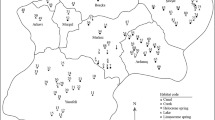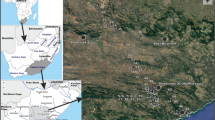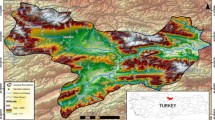Abstract
The diversity of Ostracoda in Central Serbia is relatively unknown. With the aim of exploring this diversity, and increasing the overall knowledge on their ecology, this study was carried out over a mountainous area in Central Serbia and some parts of the Vojvodina province. In total, 46 samples were collected from 36 water bodies, with several different habitat types. Ostracods were present in 22 of those water bodies, at 27 sites. A total of 17 species were recorded, six of which are new additions to the fauna of Serbia. A multivariate analysis (Canonical Correspondence Analysis) of ostracod communities and their relationship with measured environmental factors is given, with four out of five measured environmental factors showing a significant relationship with the distribution of recorded species. These were water temperature, altitude, electrical conductivity and dissolved oxygen, while pH was not significant. A cluster analysis (UPGMA) of the samples in which ostracods occurred was also performed using Jaccard distances. It grouped samples into 7 clusters, primarily defined by presence/absence of certain species. In addition, the proportion of non-cosmopolitan ostracod species was calculated for each sample, as well as for geographically grouped samples, to investigate if the percentage of non-cosmopolitan species potentially correlates with the observable state of sampling sites, mainly in terms of anthropogenic pressure and/or habitat degradation.



Similar content being viewed by others
Data availability statement
All gathered data is available at request from authors
Change history
15 April 2024
A Correction to this paper has been published: https://doi.org/10.1007/s10452-024-10096-4
References
Akdemir D, Külköylüoğlu O (2021) Effects of temperature changes on the spatial distribution and ecology of ostracod (crustacea) species. J Limnol Freshw Fisheries Res 7(1):1–13. https://doi.org/10.17216/LimnoFish.765049
Akita LG, Frenzel P, Wang J, Börner N, Peng P (2016) Spatial distribution and ecology of the recent Ostracoda from Tangra Yumco and adjacent waters on the southern tibetan plateau: a key to palaeoenvironmental reconstruction. Limnologica 59:21–43. https://doi.org/10.1016/j.limno.2016.03.005
Barrantes G, Sandoval L (2009) Conceptual and statistical problems associated with the use of diversity indices in ecology. Rev Biol Trop 57(3):451–460. https://doi.org/10.15517/rbt.v57i3.5467
Barut IF, Nazik A, Balkıs N, Aksu A, Erşan MS (2015) Ostracoda as bio-indicators of anthropogenic impact in salt lakes, saltpans, and a lagoon: a case study from the gulf of saros coast (NE aegean sea). Turkey Revue De Micropaléontologie 58(4):351–367. https://doi.org/10.1016/j.revmic.2015.10.001
Brady GS, Robertson D (1870) Notes on Entomostraca taken chiefly in the northumberland and durham district (1869). Nat Hist Trans Northumberl Durh 3(1868–1870):361–437
Brady GS (1868) A monograph of the recent british Ostracoda Vol. 26. Taylor and Francis.
Carbonel P, Colin JP, Danielopol DL, Löffler H, Neustrueva I (1988) Paleoecology of limnic ostracodes: a review of some major topics. Palaeogeogr Palaeoclimatol Palaeoecol 62(1–4):413–461
Chang CY, Lee J, Smith RJ (2012) Nonmarine ostracods (Crustacea) from South Korea, including a description of a new species of Tanycypris Triebel (Cyprididae, Cypricercinae). Zootaxa 3161(1):1–19. https://doi.org/10.11646/ZOOTAXA.3161.1.1
Cronin TM, Keller KJ, Farmer JR, Schaller MF, O’Regan M, Poirier R, Coxall H, Dwyer GS, Bauch H, Kindstedt IG, Jakobsson M, Marzen R, Santin E (2019) Interglacial paleoclimate in the Arctic. Paleoceanogr Paleoclimatol 34(12):1959–1979. https://doi.org/10.1029/2019PA003708
Cvetković-Miličić D, Petrov B, Žnidaršič TK, Petrov I (2005) On the crustaceans of shallow waters and springs of Stara Planina Mountains in Serbia. Proceedings of balkan scientific conference of biology. plovdiv university press, Plovdiv (2):385–391
Dudgeon D (2020) Freshwater biodiversity. Cambridge University Press, Cambridge. https://doi.org/10.1017/9781139032759
Griffiths HI, Pillidge KE, Hill CJ, Evans JG, Learner MA (1996) Ostracod gradients in a calcareous stream: implications for the palaeoecological interpretation of tufas and travertines. Limnologica 26(1):49–62
Hammer Ø (2023) PAST - PAleontological STatistics, Version 4.13, Reference manual
Hoehle M, Wrozyna C (2022) Spatio-temporal distribution of ostracod species in saline inland lakes (Mansfeld lake area; Central Germany). PeerJ 10:e13668
Horne DJ, Mezquita F (2008) Palaeoclimatic applications of large databases: developing and testing methods of palaeotemperature reconstruction using nonmarine ostracods. Senckenb Lethaea 88(1):93–112
Horne DJ, Cohen A, Martens K (2002) Taxonomy, morphology and biology of quaternary and living Ostracoda. Wash DC Am Geophys Union Geophys Monogr Ser 131:5–36
Ikeya N, Tsukagoshi A, Horne DJ (2005) The phylogeny, fossil record and ecological diversity of ostracod crustaceans. Hydrobiologia 538:vii–xiii
Karan T, Petrov B (2000) A review of the investigations, preliminary list of species and diversity estimation of freshwater and terrestrial crustaceans of the Balkans and FR Yugoslavia. Part 1. Ekologija 35:1–44
Karanovic I, Lee W (2013) On the ostracod genus Ilyocypris, with description of one new species from Korea and the first report of males of I bradyi (Crustacea: Ostracoda: Podocopida). Proc Biol Soc Wash 126(1):39–71
Karanović I (1996) Fauna ostrakoda (Ostracoda, Crustacea) Fruške Gore (Vojvodina, Jugoslavija). Masters dissertation, Novi sad.
Karan-Žnidaršič T, Stojanović K, Božanić M, Novaković B, Perić A, Živić M, Živić I (2016) Ostracoda (Crustacea) in lotic mountain-river habitats in Serbia. 5th Congress of Ecologists of the Republic of Macedonia with International Participation, Ohrid, Macedonia, Abstract book: 90
Karan-Žnidarsic T, Petrov B (2007) Non-marine Ostracoda (Crustacea) of banat district in Serbia. Hydrobiologia 585:57–66. https://doi.org/10.1007/s10750-007-0628-3
Klie W (1940) Zur Kenntnis der Ostracodenarten Candona eremita (Vejd.) und Candona reducta (Alm). Mitteilungen Über Höhlen- Und Karstforschung 1:24–29
Krebs CJ (2014) Ecology: The experimental analysis of distribution and abundance. Pearson education Ltd pp 646
Külköylüoğlu O (2004) On the usage of ostracods (Crustacea) as bioindicator species in different aquatic habitats in the Bolu region. Turkey Ecol Indic 4(2):139–147. https://doi.org/10.1016/j.ecolind.2004.01.004
Külköylüoğlu O (2013) Diversity, distribution and ecology of nonmarine Ostracoda (Crustacea) in Turkey: application of pseudorichness and cosmoecious species concepts. Recent Res Develop Ecol 4:1–18
Külköylüoğlu O (2023) Ostracoda (Crustacea) and limnoecological characteristics of lake Karamurat (Bolu, Turkey): testing pseudorichness hypothesis. Int J Limnol 59:1. https://doi.org/10.1051/limn/2022017
Külköylüoğlu O, Sarı N (2012) Ecological characteristics of the freshwater Ostracoda in Bolu Region (Turkey). Hydrobiologia 688:37–46. https://doi.org/10.1007/s10750-010-0585-0
Külköylüoğlu O, Yavuzatmaca M, Akdemir D, Çelen E, Dalkıran N (2018) Ecological classification of the freshwater Ostracoda Crustacea based on physicochemical properties of waters and habitat preferences. Ann De Limnolog Int J Limnol 54:26
Külköylüoğlu O (2007) Ostracod Pseudorichness: Is it real? EOM VI Frankfurt, Germany 03 – 07 September 2007. 19th International Senckenberg conference—european Ostracodologist’s Meeting. Abstract 61
Legendre P, Gallagher ED (2001) Ecologically meaningful transformations for ordination of species data. Oecologia 129:271–280
Liperovskaya ES (1948). On the feeding of freshwater ostracods.Translation of Zoologicheskij zhurnal. 27(2):125–136
Ma S, Yu N (2018) Freshwater ostracods (Crustacea) from Tiantong national forest park and Dongqian Lake, eastern China, with descriptions of two new species. J Nat Hist 52(27–28):1825–1868. https://doi.org/10.1080/00222933.2018.1489085
Martens K (1996) On Heterocypris reptans (Kaufmann, 1900) (Ostracoda) cyprididae, a new record of Israel. Isr J Zool 42(3):287–291. https://doi.org/10.1080/00212210.1996.10688849
Martens K, Savatenalinton S (2011) A subjective checklist of the recent, free-living, non-marine Ostracoda Crustacea, Ostracoda. Zootaxa 2855:1–79. https://doi.org/10.11646/zootaxa.2855.1.1
Martens K, Schön I, Meisch C, Horne DJ (2008) Global diversity of ostracods (Ostracoda, Crustacea) in freshwater. Hydrobiologia 595:185–193
Martens K, Shribak M, Arkhipova I, Schön I (2023) The common morphospecies Cypridopsis vidua (OF MÜLLER, 1776) (Crustacea, Ostracoda) is not an obligate parthenogen. Belg J Zool 153:15–34. https://doi.org/10.26496/bjz.2023.107
Martens K, Behen F (1994) A checklist of the recent non-marine ostracods (Crustacea, Ostracoda) from the inland waters of South america and adjacent islands (Vol. 22). Ministère des affaires culturelles, Musée national d'histoire naturelle
McGill BJ, Etienne RS, Gray JS, Alonso D, Anderson MJ, Benecha HK, White EP (2007) Species abundance distributions: moving beyond single prediction theories to integration within an ecological framework. Ecol Lett 10(10):995–1015
Meisch C, Wouters K (1985) Potamocypris arcuata (Sars, 1903), new to hungary, (Crustacea, Ostracoda). Miscellanea Zoologica Hungarica 3:73–76
Meisch C, Smith RJ, Martens K (2019) A subjective global checklist of the extant non-marine Ostracoda (Crustacea). Europ J Taxon 492:1–135
Meisch, C. (2000). Crustacea: Ostracoda. Süßwasserfauna von Mitteleuropa. 8(3) Spektrum Akademischer Verlag GmbH, Heidelberg, Berlin
Mesquita-Joanes F, Smith AJ, Viehberg FA (2012) The ecology of Ostracoda across levels of biological organisation from individual to ecosystem: a review of recent developments and future potential. Develop Quat Sci 17:15–35
Mezquita F, Griffiths HI, Domínguez MI, Lozano-Quilis MA (2001) Ostracoda (Crustacea) as ecological indicators: a case study from Iberian Mediterranean brooks. Arch Hydrobiol 150(4):545–560. https://doi.org/10.1127/archiv-hydrobiol/150/2001/545
Mezquita F, Roca JR, Reed JM, Wansard G (2005) Quantifying species–environment relationships in non-marine Ostracoda for ecological and palaeoecological studies: examples using Iberian data. Palaeogeogr Palaeoclimatol Palaeoecol 225(1–4):93–117. https://doi.org/10.1016/j.palaeo.2004.02.052
Mikulić F (1970) Neki aspekti distribucije vrsta roda Dolerocypris Kaufm. u okolini Beograda. Glasnik Prirodnjačkog Muzeja u Beogradu (Serija B)25:229–331
Ministarstvo zaštite životne sredine/Agencija za zaštitu životne sredine (2020) Rezultati ispitivanja kvaliteta površinskih i podzemnih voda – 2020. Beograd
Ministarstvo zaštite životne sredine/Agencija za zaštitu životne sredine (2021) Rezultati ispitivanja kvaliteta površinskih i podzemnih voda – 2021. Beograd
Nadal MF, González A, Avalos G (2022) Exclusion of tourist species from assemblages in ecological studies: a methodological approach using spiders. Ecol Process 11(1):1–20. https://doi.org/10.1186/s13717-022-00398-6
Neale JW (1964) Some factors influencing the distribution of recent british Ostracoda. Pubblicazioni Della Stazione Zoologica Di Napoli 33:247–307
Ottonello D, Romano A (2011) Ostracoda and Amphibia in temporary ponds: who is the prey? Unexpected trophic relation in a mediterranean freshwater habitat. Aquat Ecol 45:55–62
Petkovski TK (1959) Beitrag zur Kenntnis der Ostracodenfauna Jugoslawiens (V). Hidrobiologi 4:158–165
Petkovski TK (1961) Zur Kenntnis der Crustaceen des Skadar (Scutari-) Sees. Acta Musei Macedonici Scientiarum Naturalium, VIII 2:29–52
Petkovski TK (1964) Bemerkenswerte Entomostraken aus Jugoslawien. Acta Musei Macedonici Scientiarum Naturalium IX 7:147–182
Petkovski TK (1969) Einige neue und Bemerkenswerte Candoninae aus dem Ohridsee und einigen anderen Fundorten in Europa (Crustacea – Ostracoda). Acta Musei Macedonici Scientiarum Naturalium XI 5:82–111
Petkovski TK, Scharf B, Keyser D (2000) New and little known ostracods of the genus Heterocypris (Crustacea, Ostracoda) from the balkan Peninsula. Limnologica 30:45–57
Petkovski TK (1960) Süsswasserostracoden aus Jugoslawien VII. Fragmenta Balcanica III12: 99–106
Petrov B, Miličić D, Karan-Žnidaršič T (2007) Branchiopode and Ostracode Crustaceans of special nature reservate Zasavica (Crustacea: Branchiopoda, Ostracoda). Conf Zasavica 2007:153–157
Pieri V, Vandekerkhove J, Goi D (2012) Ostracoda (Crustacea) as indicators for surface water quality: a case study from the ledra river basin (NE Italy). Hydrobiologia 688:25–35. https://doi.org/10.1007/s10750-010-0568-1
Pokrajac J, Karan-Žnidaršič T, Stamenković S (2022) Diversity and seasonal dynamics of freshwater Ostracoda (Crustacea) in Petnica (Serbia). 6th congress of ecologists of the republic of macedonia with international participation, Ohrid, Macedonia, Abstract book: 142
Radaković MG, Tošić I, Bačević N, Mladjan D, Gavrilov MB, Marković SB (2018) The analysis of aridity in Central Serbia from 1949 to 2015. Theoret Appl Climatol 133:887–898. https://doi.org/10.1007/s00704-017-2220-8
Ruiz F, Abad M, Bodergat AM, Carbonel P, Rodríguez-Lázaro J, Gonzá-lez-Regalado ML, Toscano A, García EX, Prenda J (2013) Freshwater ostracods as environmental tracers. Int J Environ Sci Technol 10:1115–1128. https://doi.org/10.1007/s13762-013-0249-5
Rundić LM (2006) Late Miocene ostracodes of Serbia: morphologic and palaeoenvironmental considerations. Geoloski Anali Balkanskoga Poluostrva 67:89–100. https://doi.org/10.2298/GABP0667089R
Sant K, Mandic O, Rundić L, Kuiper KF, Krijgsman W (2018) Age and evolution of the serbian lake system: integrated results from middle miocene lake popovac. Newsl Stratigr 51(1):117–143. https://doi.org/10.1127/nos/2016/0360
Sasaki S, Irizuki T, Seto K, Suganuma Y (2022) Ostracoda and paleoenvironment of Holocene-raised beach sediment in Skarvsnes. East Antarctica Paleontological Research 26(4):440–454. https://doi.org/10.2517/PR210011
Savatenalinton S, Martens K (2009) Generic revision of cypricercinae McKenzie, 1971 (Crustacea, Ostracoda), with the description of three new genera and one new species and a phylogenetic analysis of the subfamily. Hydrobiologia 632:1–48. https://doi.org/10.1007/s10750-009-9826-5
Savatenalinton S, Martens K (2010) On the subfamily Cypricercinae McKenzie, 1971 (Crustacea, Ostracoda) from thailand, with the description of six new species. Zootaxa 2379:1–77. https://doi.org/10.11646/zootaxa.2379.1.1
Schön I, Mesquita-Joanes F, Vandenboer Y, Martens K (2023) Natural populations of the putative ancient asexual Darwinula stevensoni (Crustacea, Ostracoda) differ in their microbiomes. Hydrobiologia 850:3719–3741. https://doi.org/10.1007/s10750-023-05257-9
Smith AJ, Delorme LD (2010) Ostracoda. In: Thorp JH, Covich AP (eds) Ecology and classification of north american freshwater invertebrates. Academic Press, Cambridge, pp 725–771
Smith AJ, Horne DJ, Martens K, Schön I (2015a) Class Ostracoda. In: Thorp J, Rogers DC (eds) Thorp and Covich’s freshwater invertebrates, 4th edn. Elsevier, ecology and general biology, Amsterdam, pp 757–780
Smith RJ, Lee J, Chang CY (2015b) Nonmarine Ostracoda (Crustacea) from Jeju Island, South Korea, including descriptions of two new species. J Nat Hist 49(1–2):37–76. https://doi.org/10.1080/00222933.2014.946110
Smol JP (2009) Pollution of lakes and rivers: a paleoenvironmental perspective. John Wiley and Sons
Tan CWJ, Gouramanis C, Pham TD, Hoang DQ, Switzer AD (2021) Ostracods as pollution indicators in lap an lagoon, central vietnam. Environ Pollut 278:116762. https://doi.org/10.1016/j.envpol.2021.116762
Ter Braak CJF, Šmilauer P (2018) Canoco reference manual and user’s guide: software for ordination, version 5.1x. Microcomputer Power, Ithaca, USA, p 536
Van Doninck K, Schön I, Martens K, Goddeeris B (2003) The life-cycle of the asexual ostracod Darwinula stevensoni (Brady and Robertson, 1870) (Crustacea, Ostracoda) in a temporate pond. Hydrobiologia 500(1–3):331–340. https://doi.org/10.1023/A:1024656920904
Wang C, Kuang X, Wang H, Guo G, Song G (2021) Ostracods as a proxy for paleoclimatic change: an essential role of bioculture experiment taking Limnocythere inopinata (Crustacea: Ostracoda) as an example. Ecol Ind 121:107000. https://doi.org/10.1016/j.ecolind.2020.107000
Watson R, Baste I, Larigauderie A, Leadley P, Pascual U, Baptiste B, Mooney H (2019) Summary for policymakers of the global assessment report on biodiversity and ecosystem services of the intergovernmental science-policy platform on biodiversity and ecosystem services. IPBES Secretariat: Bonn, Germany, 22–47
Yavuzatmaca M (2020) Species assemblages of Ostracoda (Crustacea) from west-site of turkey: their indicator potential for lotic and lentic habitats. Biologia 75(12):2301–2314
Yin ZY, Zeng L, Luo SM, Chen P, He X, Guo W, Li B (2018) Examining the patterns and dynamics of species abundance distributions in succession of forest communities by model selection. PLoS ONE 13(5):e0196898
Zhai DY, Zhao W (2014) On some recent non-marine Ostracods from Northern China, with description of a new species. Crustaceana 87:985–1026. https://doi.org/10.1163/15685403-00003339
Acknowledgements
We sincerely thank all our colleagues, friends and family members who have supported us in the realization of this study. Special thanks go to Nevena Batinić Pokrajac for her invaluable help improving the quality of English language in this paper.
Funding
The results of this study were financed by the Ministry of Education, Science and Technological development (contract No. 451-03-47/2023-01/200178).
Author information
Authors and Affiliations
Contributions
Conceptualization and Methodology, J.P. and T.K-Ž.; Validation, T.K-Ž.; Sampling, J.P. and K.S.; Identification, T.K-Ž. and J.P.; Software and Statistical analysis, S.S.; Investigation, J.P. and T.K-Ž.; Writing – original draft, J.P.; Writing – review and editing, T.K-Ž., S.S., K.S. and J.P.; Supervision, T.K-Ž. and S.S.
Corresponding author
Ethics declarations
Conflicts of interest
The authors declare no conflict of interest.
Additional information
Handling Editor : S.S.S. Sarma.
Publisher's Note
Springer Nature remains neutral with regard to jurisdictional claims in published maps and institutional affiliations.
The original online version of this article was revised: tables were updated.
Rights and permissions
Springer Nature or its licensor (e.g. a society or other partner) holds exclusive rights to this article under a publishing agreement with the author(s) or other rightsholder(s); author self-archiving of the accepted manuscript version of this article is solely governed by the terms of such publishing agreement and applicable law.
About this article
Cite this article
Pokrajac, J., Stojanović, K., Stamenković, S. et al. Diversity and ecology of freshwater Ostracoda (Crustacea) in Central Serbia. Aquat Ecol (2024). https://doi.org/10.1007/s10452-024-10094-6
Received:
Accepted:
Published:
DOI: https://doi.org/10.1007/s10452-024-10094-6




